(新)高考英语阅读理解之掌握主旨大意
- 格式:doc
- 大小:63.00 KB
- 文档页数:6
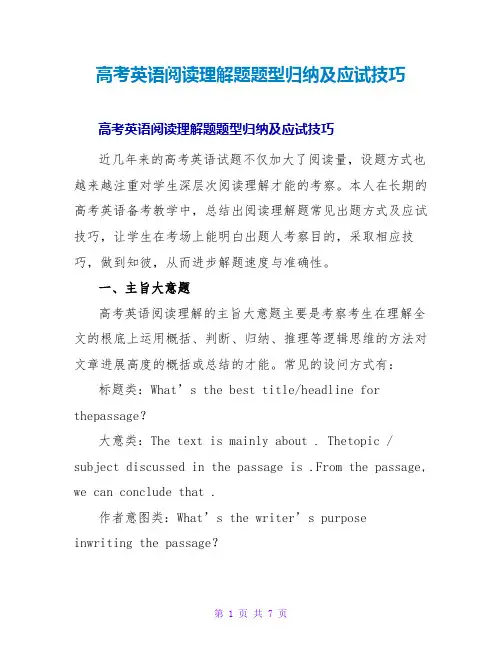
高考英语阅读理解题题型归纳及应试技巧高考英语阅读理解题题型归纳及应试技巧近几年来的高考英语试题不仅加大了阅读量,设题方式也越来越注重对学生深层次阅读理解才能的考察。
本人在长期的高考英语备考教学中,总结出阅读理解题常见出题方式及应试技巧,让学生在考场上能明白出题人考察目的,采取相应技巧,做到知彼,从而进步解题速度与准确性。
一、主旨大意题高考英语阅读理解的主旨大意题主要是考察考生在理解全文的根底上运用概括、判断、归纳、推理等逻辑思维的方法对文章进展高度的概括或总结的才能。
常见的设问方式有:标题类:W hat’s the best title/headline for thepassage?大意类:The text is mainly about . Thetopic / subject discussed in the passage is .From the passage, we can conclude that .作者意图类:What’s the writer’s purposeinwriting the passage?针对主旨大意类型的题,考生可以掌握以下解题策略:把握文章逻辑构造,快速找出主题;寻找主题句,确定文章中心思想;将首段中心句和各段第一句话连接成一个整体,得出文章主题;逆向思维法解标题类问题。
此类题关键在于通读全文,理解作者写作意图,不受干扰项细节影响,要把握好文章的大意,抓住文章的主题句,还应注意文章的体裁及写作目的。
二、数据推断题解答此类题,关键是要擅长捕捉有关数字的信息,然后在透彻理解原文的字面意义和题意的根底上,运用自己的数学知识,分列数字,对其进展分析^p 、推算,从而得出正确的结论。
如阅读理解题:……But now there is a Winter-swimmingEnthusiasts’Club and it has more than 2.000 mem.bers. The oldest is 84 years old and the youngest isonly 7. The members are from all walks oflife ……The question is : Among the winter-swimmersthe oldest is _____ years older than the youngestone.A. 91B. 84 C . 77 D. 7答案是C。

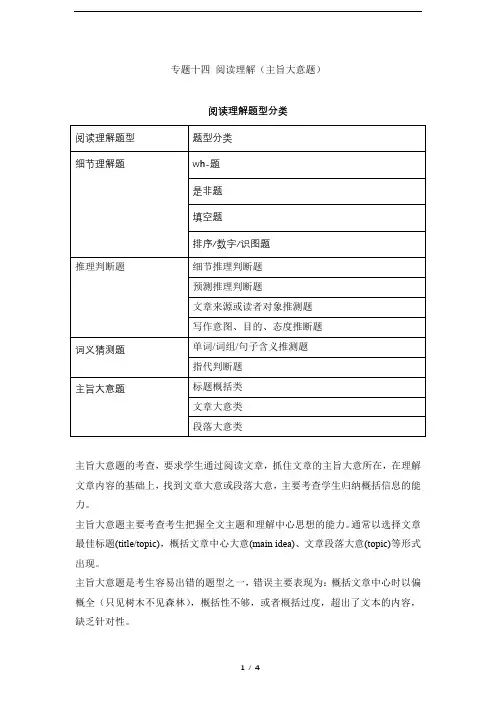
专题十四阅读理解(主旨大意题)阅读理解题型分类主旨大意题的考查,要求学生通过阅读文章,抓住文章的主旨大意所在,在理解文章内容的基础上,找到文章大意或段落大意,主要考查学生归纳概括信息的能力。
主旨大意题主要考查考生把握全文主题和理解中心思想的能力。
通常以选择文章最佳标题(title/topic),概括文章中心大意(main idea)、文章段落大意(topic)等形式出现。
主旨大意题是考生容易出错的题型之一,错误主要表现为:概括文章中心时以偏概全(只见树木不见森林),概括性不够,或者概括过度,超出了文本的内容,缺乏针对性。
一、主旨大意题的分类主旨大意题的分类及其常见设问形式1. 标题概括类做此类试题时,要注意标题的三个特性,即醒目性、概括性和针对性。
解题时要抓住文章的首尾段和每一段的首尾句,要注意贯穿文章始终的词语。
常见设问形式有:What is the best title for this passage?Which of the following is the best title of the passage?What can be a suitable title for the text?What might be the best title for the passage?The best title of the passage is ______.The suitable headline of the passage may be ______.2. 文章大意类每篇文章都有中心思想,可以通过找主题句来获取文章中心思想。
主题句通常在首段或结尾段,但有时也会出现在文章的中间段落。
因此,在阅读时要倍加关注文章的首段和结尾段及各个段落的主题句。
常见设问形式有:What is the main idea of the passage?Which of the following can best summarize the passage?What is the message conveyed in the story?What does the passage mainly present?What is the main theme of the story?What does the story mainly tell us?What does the passage mainly talk about?The passage is mainly about ______.The main purpo se of the passage is to ______.The passage is mainly written to ______.3. 段落大意类每个段落通常都有一个中心思想,通常会在本段首句体现出来,即常说的段落主题句。
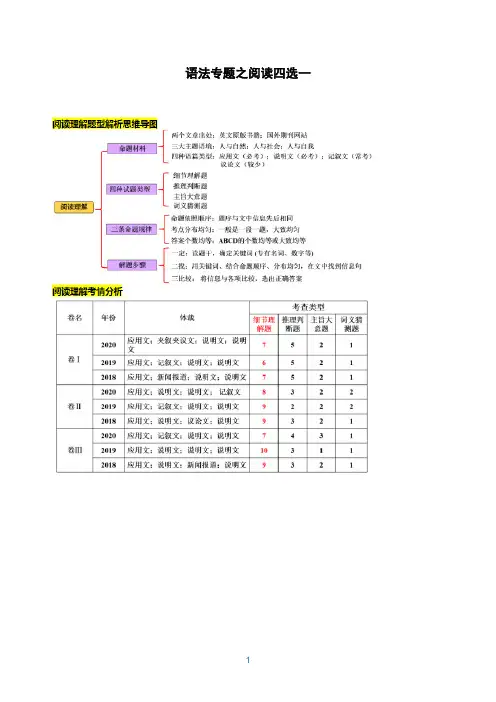
语法专题之阅读四选一一、基本解题思路:四步兵法1、扫描题干,划关键项。
2、通读全文,抓住中心。
3、仔细审题,返回原文。
(仔细看题干,把每道题和原文的某处建立联系,挂起钩)定位原则:要树立定位意识,每一题、每一选项都要回到原文中某一处定位。
4、重叠选项,得出答案。
(重叠原文=对照原文)① 通常是由题干出发,使用寻找关键词定位原则。
(关键词:大写字母、地名、时间、数字等) ② 自然段定位原则。
出题的顺序与行文的顺序是基本一致的,一般每段对应一题。
1. 通过题干返回原文:判断四个选项,抓住选项中的关键词,把选项定位到原文的某处比较,重叠选项,选出答案。
2. 作题练习要求:要有选一个答案的理由和其余三个不选的理由。
二、常考类型题:1、主旨大意题:1)意义:主旨大意是作者在文章中要表达的主要内容,是全文的核心,作者在文章中努力通过各种细节信息来阐明中心话题。
因此,把握主旨大意对于正确理解全文具有重要意义。
要找出主旨大意,应采用快速阅读法浏览全文,阅读时要注意抓住表达中心思想的句子。
文章不同,中心句在文章中的位置也就不同,但一般情况下阅读时应特别留意文章的开头、结尾及各个段落的首句和尾句,因为它们往往包含文章的中心议题。
2)常见的提问方式:★What is the main idea of this passage?★What does this passage mainly concern?★The main theme of this passage is_____________★The main point of the passage is___________★Which of the following is the best title for the passage?★The title that best expresses the theme of the passage is______★The purpose of the writer writing this passage is_____★Which of the following best describes the passage as a whole?3)主题句的位置:1.主题句位于段首。
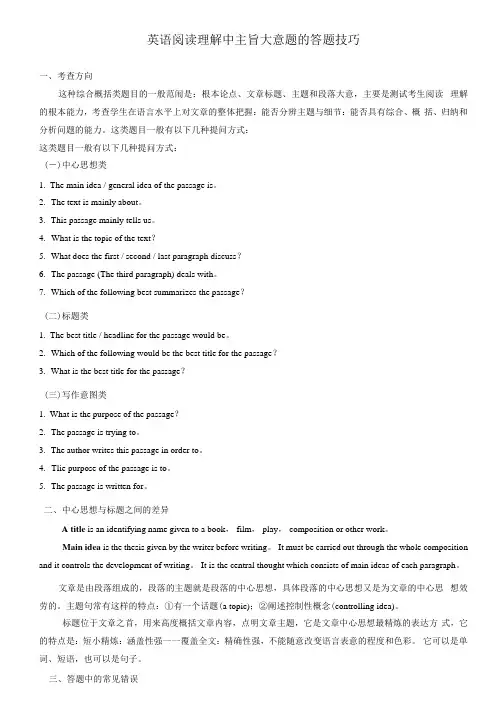
英语阅读理解中主旨大意题的答题技巧一、考查方向这种综合概括类题目的一般范闱是:根本论点、文章标题、主题和段落大意,主要是测试考生阅读理解的根本能力,考查学生在语言水平上对文章的整体把握:能否分辨主题与细节:能否具有综合、概括、归纳和分析问题的能力。
这类题目一般有以下几种提问方式:这类题目一般有以下几种提问方式:(―)中心思想类1.The main idea / general idea of the passage is。
2.The text is mainly about。
3.This passage mainly tells us。
4.What is the topic of the text?5.What does the first / second / last paragraph discuss?6.The passage (The third paragraph) deals with。
7.Which of the following best summarizes the passage?(二)标题类1.The best title / headline for the passage would be。
2.Which of the following would be the best title for the passage?3.What is the best title for the passage?(三)写作意图类1.What is the purpose of the passage?2.The passage is trying to。
3.The author writes this passage in order to。
4.Tlie purpose of the passage is to。
5.The passage is written for。
二、中心思想与标题之间的差异A title is an identifying name given to a book, film, play, composition or other work。
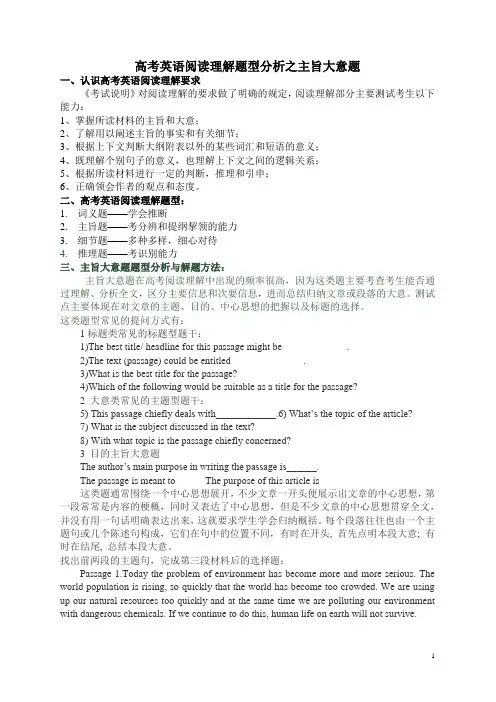
高考英语阅读理解题型分析之主旨大意题一、认识高考英语阅读理解要求《考试说明》对阅读理解的要求做了明确的规定,阅读理解部分主要测试考生以下能力:1、掌握所读材料的主旨和大意;2、了解用以阐述主旨的事实和有关细节;3、根据上下文判断大纲附表以外的某些词汇和短语的意义;4、既理解个别句子的意义,也理解上下文之间的逻辑关系;5、根据所读材料进行一定的判断,推理和引申;6、正确领会作者的观点和态度。
二、高考英语阅读理解题型:1.词义题——学会推断2.主旨题——考分辨和提纲挈领的能力3.细节题——多种多样,细心对待4.推理题——考识别能力三、主旨大意题题型分析与解题方法:主旨大意题在高考阅读理解中出现的频率很高,因为这类题主要考查考生能否通过理解、分析全文,区分主要信息和次要信息,进而总结归纳文章或段落的大意。
测试点主要体现在对文章的主题、目的、中心思想的把握以及标题的选择。
这类题型常见的提问方式有:1标题类常见的标题型题干:1)The best title/ headline for this passage might be_____________.2)The text (passage) could be entitled ______________.3)What is the best title for the passage?4)Which of the following would be suitable as a title for the passage?2 大意类常见的主题型题干:5) This passage chiefly deals with____________.6) What’s the topic of the article?7) What is the subject discussed in the text?8) With what topic is the passage chiefly concerned?3 目的主旨大意题The author’s main purpose in writing the passage is______.The passage is meant to _____ The purpose of this article is _______这类题通常围绕一个中心思想展开,不少文章一开头便展示出文章的中心思想,第一段常常是内容的梗概,同时又表达了中心思想,但是不少文章的中心思想贯穿全文,并没有用一句话明确表达出来,这就要求学生学会归纳概括。
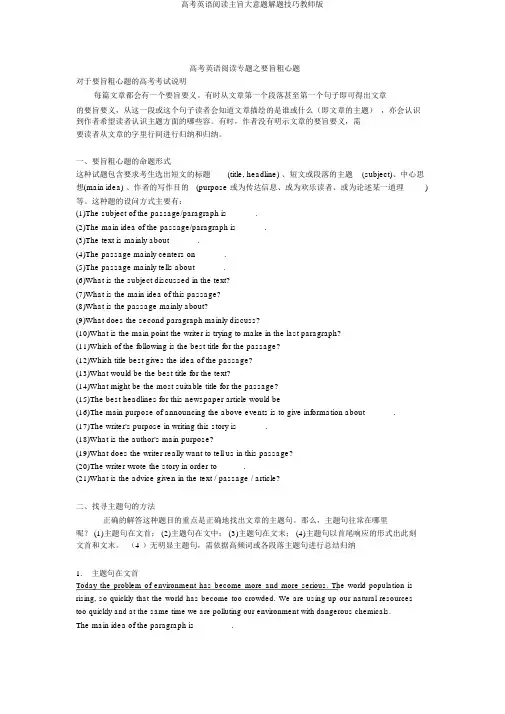
高考英语阅读专题之要旨粗心题对于要旨粗心题的高考考试说明每篇文章都会有一个要旨要义。
有时从文章第一个段落甚至第一个句子即可得出文章的要旨要义,从这一段或这个句子读者会知道文章描绘的是谁或什么(即文章的主题),亦会认识到作者希望读者认识主题方面的哪些容。
有时,作者没有明示文章的要旨要义,需要读者从文章的字里行间进行归纳和归纳。
一、要旨粗心题的命题形式这种试题包含要求考生选出短文的标题(title, headline) 、短文或段落的主题(subject)、中心思想(main idea) 、作者的写作目的(purpose 或为传达信息、或为欢乐读者、或为论述某一道理)等。
这种题的设问方式主要有:(1)The subject of the passage/paragraph is ______.(2)The main idea of the passage/paragraph is ______.(3)The text is mainly about ______.(4)The passage mainly centers on ______.(5)The passage mainly tells about ______.(6)What is the subject discussed in the text?(7)What is the main idea of this passage?(8)What is the passage mainly about?(9)What does the second paragraph mainly discuss?(10)What is the main point the writer is trying to make in the last paragraph?(11)Which of the following is the best title for the passage?(12)Which title best gives the idea of the passage?(13)What would be the best title for the text?(14)What might be the most suitable title for the passage?(15)The best headlines for this newspaper article would be______(16)The main purpose of announcing the above events is to give information about ______.(17)The writer's purpose in writing this story is ______.(18)What is the author's main purpose?(19)What does the writer really want to tell us in this passage?(20)The writer wrote the story in order to______.(21)What is the advice given in the text / passage / article?二、找寻主题句的方法正确的解答这种题目的重点是正确地找出文章的主题句。
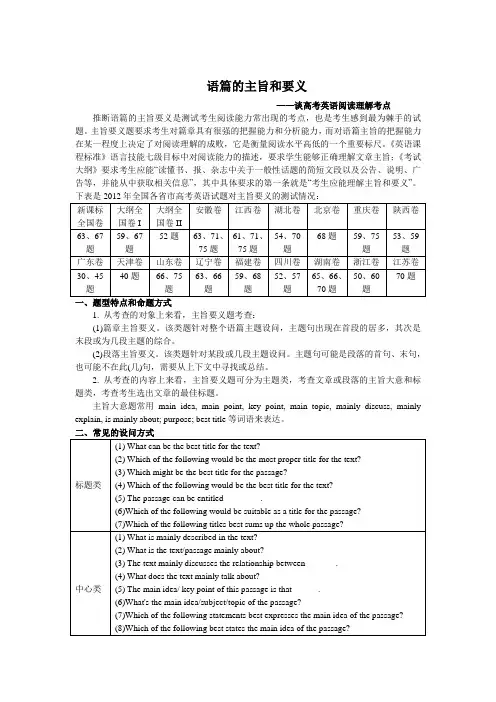
语篇的主旨和要义——谈高考英语阅读理解考点推断语篇的主旨要义是测试考生阅读能力常出现的考点,也是考生感到最为棘手的试题。
主旨要义题要求考生对篇章具有很强的把握能力和分析能力,而对语篇主旨的把握能力在某一程度上决定了对阅读理解的成败,它是衡量阅读水平高低的一个重要标尺。
《英语课程标准》语言技能七级目标中对阅读能力的描述,要求学生能够正确理解文章主旨;《考试大纲》要求考生应能“读懂书、报、杂志中关于一般性话题的简短文段以及公告、说明、广告等,并能从中获取相关信息”,其中具体要求的第一条就是“考生应能理解主旨和要义”。
下表是2012年全国各省市高考英语试题对主旨要义的测试情况:1. 从考查的对象上来看,主旨要义题考查:(1)篇章主旨要义。
该类题针对整个语篇主题设问,主题句出现在首段的居多,其次是末段或为几段主题的综合。
(2)段落主旨要义。
该类题针对某段或几段主题设问。
主题句可能是段落的首句、末句,也可能不在此(几)句,需要从上下文中寻找或总结。
2. 从考查的内容上来看,主旨要义题可分为主题类,考查文章或段落的主旨大意和标题类,考查考生选出文章的最佳标题。
主旨大意题常用main idea, main point, key point, main topic, mainly discuss, mainly(1)不出现细节信息;不含过分肯定(否定)或绝对意义的词;(2)四个选项中,内容相近或完全相反的两个选项中往往有一个是正确选项;(3)那些概括全文,内容全面,含义深刻,说明道理的选项一般是答案项,而选项内容片面,单一的内容一般是错误选项。
做主旨要义题应该从话题、主题段、主题句、语篇结构等方面入手,从全局的角度对文章梳清脉络,概括归纳。
1.领悟语篇话题,做好主旨要义题。
高考所选语篇不是无病呻吟,它都有一个话题。
许多语篇中最明显的特点之一是有一个反复出现的中心词,即高频词,也叫做主题词。
抓住了它,便容易抓住文章的中心。
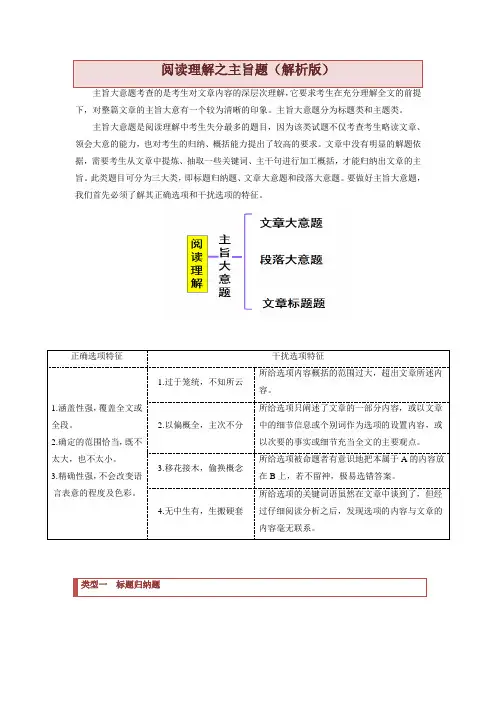
阅读理解之主旨题(解析版)主旨大意题考查的是考生对文章内容的深层次理解,它要求考生在充分理解全文的前提下,对整篇文章的主旨大意有一个较为清晰的印象。
主旨大意题分为标题类和主题类。
主旨大意题是阅读理解中考生失分最多的题目,因为该类试题不仅考查考生略读文章、领会大意的能力,也对考生的归纳、概括能力提出了较高的要求。
文章中没有明显的解题依据,需要考生从文章中提炼、抽取一些关键词、主干句进行加工概括,才能归纳出文章的主旨。
此类题目可分为三大类,即标题归纳题、文章大意题和段落大意题。
要做好主旨大意题,我们首先必须了解其正确选项和干扰选项的特征。
正确选项特征干扰选项特征1.涵盖性强,覆盖全文或全段。
2.确定的范围恰当,既不太大,也不太小。
3.精确性强,不会改变语言表意的程度及色彩。
1.过于笼统,不知所云所给选项内容概括的范围过大,超出文章所述内容。
2.以偏概全,主次不分所给选项只阐述了文章的一部分内容,或以文章中的细节信息或个别词作为选项的设置内容,或以次要的事实或细节充当全文的主要观点。
3.移花接木,偷换概念所给选项被命题者有意识地把本属于A的内容放在B上,若不留神,极易选错答案。
4.无中生有,生搬硬套所给选项的关键词语虽然在文章中谈到了,但经过仔细阅读分析之后,发现选项的内容与文章的内容毫无联系。
类型一标题归纳题一、提问方式·The best title of the passage is ________.·Which of the following is the best title of the passage?·What would be the best title for the passage?·The most appropriate title of the passage is ______.二、解题必备知能(一)理解标题的3大特点一个好的标题应具备三大特点:1.概括性——准确而又简短;2.针对性——标题外延正好与文章内容相符;3.醒目性——能引发读者的阅读欲望。
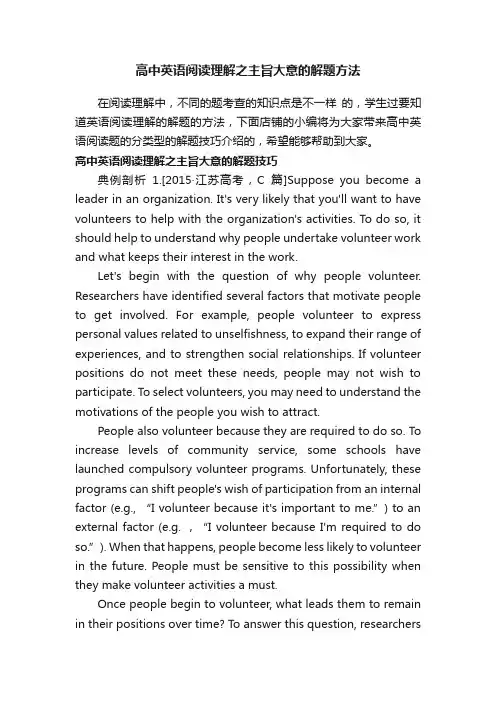
高中英语阅读理解之主旨大意的解题方法在阅读理解中,不同的题考查的知识点是不一样的,学生过要知道英语阅读理解的解题的方法,下面店铺的小编将为大家带来高中英语阅读题的分类型的解题技巧介绍的,希望能够帮助到大家。
高中英语阅读理解之主旨大意的解题技巧典例剖析1.[2015·江苏高考,C篇]Suppose you become a leader in an organization. It's very likely that you'll want to have volunteers to help with the organization's activities. To do so, it should help to understand why people undertake volunteer work and what keeps their interest in the work.Let's begin with the question of why people volunteer. Researchers have identified several factors that motivate people to get involved. For example, people volunteer to express personal values related to unselfishness, to expand their range of experiences, and to strengthen social relationships. If volunteer positions do not meet these needs, people may not wish to participate. To select volunteers, you may need to understand the motivations of the people you wish to attract.People also volunteer because they are required to do so. To increase levels of community service, some schools have launched compulsory volunteer programs. Unfortunately, these programs can shift people's wish of participation from an internal factor (e.g., “I volunteer because it's important to me.”) to an external factor (e.g. ,“I volunteer because I'm required to do so.”). When that happens, people become less likely to volunteer in the future. People must be sensitive to this possibility when they make volunteer activities a must.Once people begin to volunteer, what leads them to remain in their positions over time? T o answer this question, researchershave conducted followup studies in which they track volunteers over time. For instance, one study followed 238 volunteers in Florida over a year. One of the most important factors that influenced their satisfaction as volunteers was the amount of suffering they experienced in their volunteer positions. Although this result may not surprise you, it leads to important practical advice. The researchers note that attention should be given to “training methods that would prepare volunteers for troublesome situations or provide them with strategies for coping with the problem they do experience”.Another study of 302 volunteers at hospitals in Chicago focused on individual differences in the degree to which people view “volunteer” as an important social role. It was assumed that those people for whom the role of volunteer was most part of their personal identity would also be most likely to continue volunteer work. Participants indicated the degree to which the social role mattered by responding to statements such as “Volunteering in Hospital is an important part of who I am.” Consistent with the researchers' expectations, they found a positive correlation (正相关) between the strength of role identity and the length of time people continued to volunteer. These results, once again, lead to concrete advice: “Once an individual begins volunteering, continued efforts might focus on developing a volunteer role identity... Items like Tshirts that allow volunteers to be recognized publicly for their contributions can help strengthen role identity.”QWhat is the best title of the passage?A.How to Get People to VolunteerB.How to Study Volunteer BehaviorsC.How to Keep Volunteers' InterestD.How to Organize Volunteer Activities[答案] A 主旨大意题。
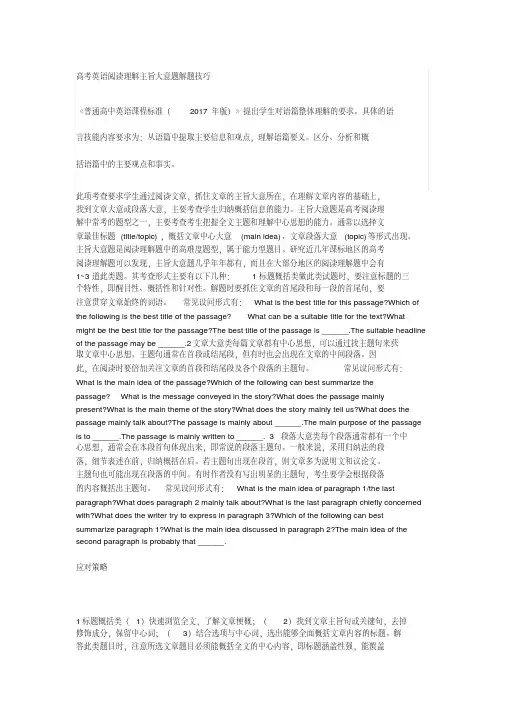
最新英语高考阅读怎么才能做对?理解技巧最全总结你必须知道的阅读理解解题方法!一、高考英语阅读题型内容1.主旨大意题任何一篇文章都有自己的中心思想,所以,文章通常是围绕该中心思想展开的。
要领悟文章的中心思想,就要具备归纳和概括方面的能力,而这种能力又常是要考查的重点。
很多文章在全文或各段的开头便展示出文章的中心思想,它主要通过主题句(TopicSentence)来体现。
一般来说,文章的主题或中心都在第一段或最后一段表明。
某一段的主题句也常出现在段首或段尾,而且常有一些表归纳关系的信号词,如inshort,Inaword,inbrief,tosumup,toconclude等。
其常用提问方式主要有:Whatisthemainidea/topicofthepassage?Thecentralpointofthes e-lectionisthat.Theauthorismainlyconcernedwith.Thepassages mainlyabout等。
2.语义猜测题该题型主要测试考生利用上下文判断单词、词组或句子在特定语言环境中确切含义的能力。
常见的提问方式有:Theword"…"inthecontextmeans.Theword"…"couldbebestreplacedby…Whichofthefollowingisnearestmeaningto?Theword"…"probablyrefersto.这不仅需要学生准确理解上下文,还要掌握或认识较多的课外词汇。
并通过构词、语法等线索确定词义。
3.细节理解题该题型主要测试学生对文章(或某一段落)中某一些特定细节或文章的重要事实的辨认能力,分直接辨认和间接辨认两种。
直接辨认细节型一般只要求学生能从阅读材料中直接获取、记住信息,然后能快速地将他们回忆出来;而间接辨认型不仅要求读者能从阅读材料中直接获取信息,还要将获得的信息进行各种转换,为阅读材料中某些词汇、短语及句型等找到正确的英语释义。
英语阅读理解中主旨大意题的答题技巧一、考查方向这种综合概括类题目的一般范围是:基本论点、文章标题、主题和段落大意,主要是测试考生阅读理解的基本能力,考查学生在语言水平上对文章的整体把握;能否分辨主题与细节;能否具有综合、概括、归纳和分析问题的能力。
这类题目一般有以下几种提问方式:这类题目一般有以下几种提问方式:(一) 中心思想类1. The main idea / general idea of the passage is _________.2. The text is mainly about ____________.3. This passage mainly tells us________________.4. What is the topic of the text?5. What does the first / second / last paragraph discuss?6. The passage (The third paragraph) deals with ____________.7. Which of the following best summarizes the passage?(二) 标题类1. The best title / headline for the passage would be ___________.2. Which of the following would be the best title for the passage?3. What is the best title for the passage?(三) 写作意图类1. What is the purpose of the passage?2. The passage is trying to ____________.3. The author writes this passage in order to _________.4. The purpose of the passage is to ______________.5. The passage is written for ________.二、中心思想与标题之间的差异A title is an identifying name given to a book, film, play, composition or other work.Main idea is the thesis given by the writer before writing. It must be carried out through the whole composition and it controls the development of writing. It is the central thought which consists of main ideas of each paragraph.文章是由段落组成的,段落的主题就是段落的中心思想,具体段落的中心思想又是为文章的中心思想服务的。
第三讲理解主旨要义——主旨大意题主旨大意题是阅读理解中难度较大的一类题目,是拉开分数差距的一个重要考查点。
因为该类试题不仅考查考生略读文章、领会大意的能力,也对考生的归纳、概括能力提出了较高的要求。
文章中没有明显的解题依据,需要考生从文章中提炼、抽取一些关键词、主干句进行加工概括,才能归纳出文章的主旨。
此类题目可分为三大类:标题归纳题、文章大意题和段落大意题。
【考查特点】Ⅰ.把握主旨大意题常见的命题方式:(1)What would be the best title for the text?/What is the topic of the text?(2)The main idea/The general idea/The main theme of this passage is ________.(3)The last paragraph ends the passage with an emphasis on ________.(4)What is mainly discussed in the text?(5)What’s the main point the writer is trying to make in the last paragraph?(6)Which of the following statements is best supported by the text?(7)The passage mainly focuses on ________.Ⅱ.掌握主旨大意题的考查角度:(1)标题类,要求考生选出文章的最佳标题。
(2)主题类(内容),考查文章或段落的主旨大意。
[考向1]标题归纳题——概括凝练选标题该类题目要求考生在理解文章的基础上,结合文章的体裁和结构,从所给选项中选出适合文章的标题。
注意最佳标题的特点:精准性强(不改变原文的意义和感情色彩);覆盖性强(能概括全文并体现文章的主旨)。
阅读理解——主旨题解题技巧主旨大意题是高考英语阅读理解中常见命题形式。
主要考查学生把握全文主旨和理解文章中心思想的能力。
主旨大意题包括选择最佳标题(title),概括文章大意、段落大意和判断作者的写作目的(purpose)等。
常见的命题形式是:What does the passage/author mainly discuss?What is the first/second paragraph mainly about?What is the main idea of the text?What is the text mainly about?What is the best title for the text?What can be a suitable title for the text?What's the purpose of the passage?一、最佳标题方法:1、中心句法:根据文章中心句,提炼主题词充当文章标题。
2、当文章的写作对象特点较多时,常用写作对象的名称充当文章的标题。
3、将文章的写作对象和其主要特点、意义或影响整合充当文章的标题。
标题的特点:概括性:抽象、准确、简短,常用一个短语或一句话。
针对性:标题外延恰当,与文章内容相符,避免以偏概全。
醒目性:新颖奇特,激发读者的阅读兴趣。
注意排除标题干扰项:(1)片面性:概括不够。
所给选项只概括了文章的一部分内容,或以文章中的细节或个别字词作为选项,或以次要信息作为标题。
(2)过于笼统或过渡概括:所给选项概括的范围过大,超出文章所述内容。
2018课标全国ⅡD篇We ‘ve all been there: in a lift, in line at the bank or on an airplane, surrounded by people who are, like us, deeply focused on their smartphones or, worse, struggling with the uncomfortable silence.What ‘s the problem? It ‘s possible that we all have compromised conversational intelligence. It ‘s more likely that none of us start a conversation because it’s awkward and challenging, or we think it’s annoying and unnecessary. But the next time you find yourself among strangers, consider that small talk is worth the trouble. Experts say it’s an invaluable social practice that results in big benefits.Dismissing small talk as unimportant is easy, but we can’t forget that deep relationships wouldn’t even exist if it weren’t for casual conversation. Small talk is the grease(润滑剂)for social communication, says Bernardo Carducci, director of the Shyness Research Institute at Indiana University Southeast.“Almost every great love story and each big business dealbegins with small talk,”he explains. “The key to successful small talk is learning how to connect with others, not just communicate with them.”In a 2014 study, Elizabeth Dunn, associate professor of psychology at UBC, invited people on their way into a coffee shop. One group was asked to seek out an interaction(互动)with its waiter; the other, to speak only when necessary. The results showed that those who chatted with their server reported significantly higher positive feelings and a better coffee shop experience.“It’s not that talking to the waiter is better than talking to your husband,”says Dunn.“But interactions with peripheral(边缘的)members of our social network matter for our well-being also.”Dunn believes that people who reach out to strangers feel a significantly greater sense of belonging, a bond with others. Carducci believes developing such a sense of belonging starts with small talk.“Small talk is the basis of good manners,”he says.35.What is the best title for the text?A.Conversation CountsB.Ways of Making Small TalkC.Benefits of Small TalkD.Uncomfortable Silence解析:中心句法。
掌握主旨大意《全日制普通高级中学英语教学大纲〔试验修订版〕》明确规定,高中英语教学目的之一是“侧重提高阅读能力”。
据此,历年全国高考英语试题都把阅读能力作为主要考查项目。
阅读能力通常指两个方面:理解和速度。
阅读速度快、理解正确率高是阅读能力强的标志。
提高阅读能力要注重阅读速度,更要注重阅读理解率。
只有阅读速度而没有阅读理解率就达不到阅读的目的。
提高阅读理解率,不仅需要大量的阅读实践,而且需要掌握阅读的基本技巧。
高考阅读理解题要求考生掌握下面六种阅读技巧:1,掌握主旨大意2。
理解具体信息3。
推测词语意义4。
推断深层含义5。
理解文章结构6。
理解作者的意图和态度这六种技巧提供了解答以多项选择为考查形式的阅读理解题的思路。
这样,就可明确考题的考查目的,掌握阅读技巧,从而提高解答阅读理解题的正确率。
掌握主旨大意主旨大意题考查对一个段落或一篇文章的主题思想的理解。
一个段落或一篇文章通常是围绕一个主题展开的,作者会从不同的角度,围绕这个主题进行阐述、论证和分析。
阅读时仅仅注意对句子的理解而忽视从语篇上对文章或段落的整体理解和把握是不够的。
如果只理解了各个单句的意思而没有抓住文章或段落的主题,其结果只能是获取了凌乱而不系统的信息,因而也就无法解答有关主旨大意题型的阅读理解题。
理解一个段落的主题思想首先要学会寻找主题句。
一般说来,在英语篇章中,主题句在段落中的位置是有规律可循的。
〔一〕主题句在段落中常见的表现形式1。
主题句在段首在有主题句的段落中,主题句往往置于段首。
英语文章的段落通常用演绎法撰写,遵循从概括到具体的写作程序,即以概述开始,随之详细解说,以支撑段落的主题。
例⒈Insects come in many sizes.Some are big and some are small.The smallest ones are so smal1that it takes one hundred of them to form one inch.The biggest insects are not big,but they are one thousand times as big as the smallest.They are about ten inches in length!第一句即为主题句,概述本段的主题思想“昆虫的大小不同”。
接着,在主题句后面的句子里,作者为阐述这个主题,指出昆虫有大有小,并对最小的昆虫和最大的昆虫分别加以陈述。
例⒉(NMET 2002)Underground systems are already in place.Many cities have underground car parks.In some cities,such as Tokyo,Seoul and Montreal, there are large underground shopping areas,The “Chunnel”,a tunnel(隧道)connecting England and France;is now complete.第一句为主题句,本段中的其他句子都是用未说明“地下设施”是以何种形式在地球上“已经存在”的具体实例。
2。
主题句在段尾与主题句位于段首的情况相反,主题句位于段尾时,段落是采用归纳法撰写的。
表述细节的句子在前,概述性的句子在后,并以此结尾。
位于段尾的主题句往往是基于上文细节得出的结论或建议,归纳出的要点或共性,得到的印象或结果等。
例3:One of the most important uses of gold is for money.Gold can be used to make rings,earings,and other things,Gold is also used to make a gold leaf, a very flat ribbon of gold that is often used on picture frames.Cups and dishes can also be made from gold. Gold has many uses. 本段共有五句。
前四句主要列举了金子的一些用途。
根据上述细节,段落的最后一句给出结论,即金子有多种用途。
这种带结论性的句子应视为主题句。
3。
主题句在段中主题句位于段中时,段首句往往是段落主题的引言,而主题则由随之引出的句子来表达。
为阐明主题思想,在主题句之后,仍有一些句子陈述细节,或做合乎逻辑的引申。
这一类的段落包括三个层次:引题——主题——解释,或提问——回答——解释。
例4People who live in countries with many doctors and modern hospitals are world’s healthiest people -- right?Not necessarily. Some groups of people who have no doctors or hospitals at all are among the world’s healthiest. For example,people who live on small, faraway islands get very few diseases because there are no outsiders to bring in germs or new illness.本段的三个层次比较明显。
第一句以设问的方式提出该文段要讨论的主题:生活在有许多医生和现代化医院的国家中的人是世界上最健康的人吗?此句起到了引出主题的作用。
第三句对前面的提问做出笼统的回答:许多生活在没有大夫和医院环境中的人也是世界上最健康的人。
此句起到了陈述主题思想的作用,应枧为主题句。
段落的最后则举例对主题做进一步的解释。
例5Joe is happy about being on a bowling team that bowls once a week. He also enjoys playing basketball twice a month. During the summer,he tries to play baseball on weekends. Joe really does enjoy all sports activities. He goes swimming as often as he can. Whenever he can’t participate directly,he loves to watch a football game or a golf or tennis match.本段的主题句为第四句Joe really does enjoy all sports activities. 前三句引述了他喜欢的几种体育活动,主题句后面的两句对中心思想做了进一步的解释和支撑。
段落结构包括三个层次:引出主题——呈现主题——解释主题。
4.主题句在段首和段尾在一些文段中,作者为了突出主题思想,采用了前后呼应,两次点题的写作手法。
值得注意的是,表述同一主题思想的两个主题句,在句型结构和措辞方面往往不尽一致,而且在内容上后者也不是前者的简单重复,往往有所引申或顺应其细节的铺叙而有所侧重。
例6Good manners are important in all countries,but ways of expressing good manners are different from country to country. Americans eat with knives and forks;Japanese eat with chopsticks. Americans say “Hi” when they meet;Japanese bow. Many American men open doors for women;Japanese men do not. On the surface,it appears that good manners in American are not good manners in Japan,and in a way this is true. But in any country,the mamers that are important are those involving one person’s behavior toward another person. In all countries it is good manners to behave considerately toward others and bad manners not to. It is only the way of behaving politely that differs from country to country.本段主要说明“礼貌在所有国家都很重要,然而各国表达礼貌的方式却不同”。
文段的第一句明确陈述了这一看法。
接着作者列举了美国人和日本人在表达礼貌上的不同方式,即不同的吃饭方式、不同的打招呼方式,以及男人对待女人的态度。
然后使用逻辑连词(but)指出礼貌之所以重要是涉及了人与人之间的行为举止,既总结上述细节,又引起一个结论性的句子作为结尾。
很明显首尾两句表述的是同一个主题思想,句型结构和用词都有不同、而且段尾的一句还顺应细节的铺述而有所侧重。
5.主题句暗含在段落中不是所有的段落都有主题句。
尤其是在含有较多段落的文章中,主题句通常不明确表述出来,而是通过对细节的陈述或各段的主要思想。
含蓄地表达段落的主题思想。
对于无主题句的段落,不可能采用辨认主题句的方法来确定其主题,而应正确理解作者提供的所有细节,包括事实、观点和事件等等形成初步印象,并根据作者提供的细节,综合归纳成一般概念。
这种概念不一定能达到主题句那样完整,但只要是切合段落的主题即可。
例7An ant can pick up an object more thanfifty time its own weight. A bee can pull a load more than one hundred andfifty times its weight. If we were as strong in proportion to our size,we could pull a five-ton truck?If we had the jumping ability of a grasshopper,we could leap a third the length of a football field!此段文章无主题句。